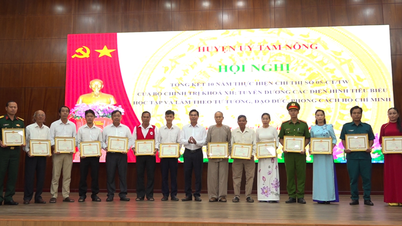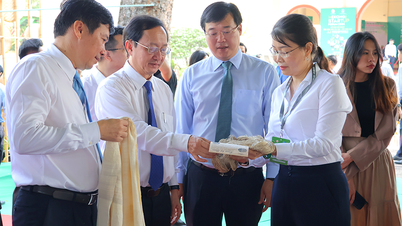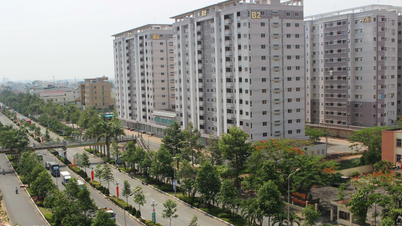Learning a trade to change production thinking, improve productivity and product quality not only helps workers in traditional craft villages "live well" from their jobs, but it is also a way to preserve, restore and promote the cultural quintessence of the craft village to friends from other provinces and around the world . That is the way that many localities have tried to do over the years.
Bong Hai mat weaving has existed for hundreds of years. According to documents in the history book of Khanh Thien Commune Party Committee, Bong Hai mat weaving (Bong Hai General, now Khanh Thien Commune, Yen Khanh District) has created products strong enough to cross the sea on merchant ships to foreign countries. In addition, skilled mat weavers in Bong Hai are involved in weaving flower mats to serve the National Assembly , with 2m wide mats made of dragon bamboo to serve international guests and high-ranking officials of the Party and State...
Mr. Hoang Cao Cu, a famous mat weaver in Khanh Thien shared: My wife and I are both nearly 80 years old, and our health is not good. But for many years, we have tried to do the job and waited. Waiting to pass on the "fire of the profession" to the younger generation, to entrust the trust and responsibility to the next generations. But no one in the younger generation wants to learn and do mat weaving anymore.
In order to preserve this hundreds of years old craft, Khanh Thien commune has made many efforts to revive, preserve and develop the mat weaving craft. The commune has also actively promoted and had support policies to attract young people to attend mat weaving classes. However, all efforts have been fruitless. The market economy has opened up many opportunities for Khanh Thien people to find other jobs with higher incomes.
So, from a profession that provided food and clothing for many generations, now in Khanh Thien there is only... 1 household left doing the job. Mr. Pham Hong Quang, Chairman of Khanh Thien Commune People's Committee regrets: In the Rural Tourism Project associated with new rural construction in the period of 2023-2030, oriented to 2040 of Khanh Thien Commune, it is regrettable that the locality cannot turn that hundreds of years old profession into a key tourism product to attract tourists because currently, the whole commune has only 1 household left doing the job. That is a great regret for the locality and for the weavers...
In reality, the case of traditional craft villages fading away like in Khanh Thien is not an isolated one. Many craft villages are facing the risk of being lost due to the indifference of the younger generation. Faced with this situation, many localities have come up with many solutions to keep the fire of the craft villages "burning" forever, thanks to efforts to teach and pass on the craft to the younger generation.

As a locality with two famous craft villages, Van Lam embroidery village and Ninh Van stone craft village, in recent years, along with promoting vocational training for rural workers, Hoa Lu District People's Committee has also paid great attention to vocational training for workers in the craft villages.
After being trained, with high skills, in line with the trend, workers will achieve a better income for the same unit of product. In addition, with a truly skilled workforce, it also contributes to preserving and developing traditional professions, preserving the cultural quintessence of the homeland.
From 2010 to present, Hoa Lu district has coordinated and provided vocational training for over 13 thousand rural workers, contributing to increasing the rate of trained workers in the district from 48.47% (in 2012) to over 60% at present. In particular, focusing on vocational training associated with enterprises and traditional craft villages; vocational training for rural workers associated with tourism development...
Workers after traditional vocational training are recruited by local businesses or self-employed, bringing stable income to workers, contributing to poverty reduction and ensuring social security in the area.
Mr. Pham Van Hoan, Head of the Department of Labor, War Invalids and Social Affairs of Hoa Lu district affirmed: Reality shows that socio-economic development based on exploiting agricultural and rural values; developing tourism associated with preserving and developing traditional craft villages, connecting craft villages with festivals and historical relics, forming eco-tours, experiential tourism... has contributed significantly to preserving and promoting traditional cultural values, while increasing income and improving the lives of people in Hoa Lu district.
Currently, the province has 245 craft villages, of which 54 have been recognized as provincial-level craft villages. Many traditional crafts are particularly famous and typical in Ninh Binh province, such as: sedge mat making in Kim Son district; stone carving in Ninh Van, embroidery in Ninh Hai commune (Hoa Lu district); bamboo and rattan weaving in Gia Tan commune (Gia Vien district); pottery in Gia Thuy commune (Nho Quan district); Phuc Loc carpentry village, Ninh Phong ward (Ninh Binh city)...
The whole province has over 24 thousand households participating in production and product processing, including 65 joint stock companies, 126 limited liability companies, 198 enterprises, 86 cooperatives and production complexes... creating jobs for a large part of the rural labor force, contributing to the positive shift in economic and labor structure.
The formation and development of craft villages not only creates a new breakthrough in economic and social development and poverty reduction, but also contributes significantly to the preservation and promotion of traditional cultural values of the nation in localities.
Most of the traditional craft villages in Ninh Binh have been recognized as cultural villages at the provincial and district levels. In particular, traditional craft villages in Ninh Binh province are also destinations in the province's tourism itinerary.
However, the reality is that many craft villages are at risk of disappearing due to the lack of young people to succeed them. Mr. Vu Manh Duong, Deputy Head of the Department of Employment and Vocational Education, Department of Labor, War Invalids and Social Affairs, said: In the coming time, the Department of Labor, War Invalids and Social Affairs will actively coordinate with localities to further strengthen vocational training activities for craft village workers, especially attracting young workers to participate in vocational training.
Because young workers always play an important role in maintaining and developing traditional crafts. They are the ones who grasp the skills, have the ability to absorb and apply advanced techniques in production, diversify products and find consumption markets. Retaining young workers in particular, and the workforce in general, is important for the existence and development of craft villages.
Dao Hang - Minh Quang
Source


![[Photo] Ready for the top competitions of Vietnamese table tennis](https://vphoto.vietnam.vn/thumb/1200x675/vietnam/resource/IMAGE/2025/5/18/9c547c497c5a4ade8f98c8e7d44f5a41)


![[Photo] Party and State leaders attend the special art program "You are Ho Chi Minh"](https://vphoto.vietnam.vn/thumb/1200x675/vietnam/resource/IMAGE/2025/5/18/6895913f94fd4c51aa4564ab14c3f250)

![[Photo] Many young people patiently lined up under the hot sun to receive a special supplement from Nhan Dan Newspaper.](https://vphoto.vietnam.vn/thumb/1200x675/vietnam/resource/IMAGE/2025/5/18/6f19d322f9364f0ebb6fbfe9377842d3)























![[Infographic] Numbers about the 2025 High School Graduation Exam in Dong Thap Province](https://vphoto.vietnam.vn/thumb/402x226/vietnam/resource/IMAGE/2025/5/17/c6e481df97c94ff28d740cc2f26ebbdc)
































































Comment (0)